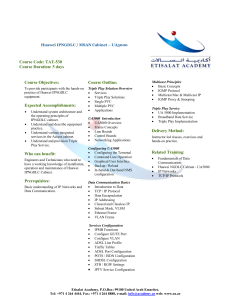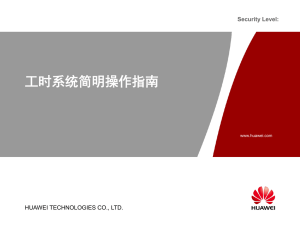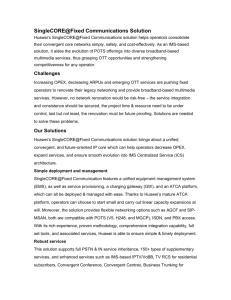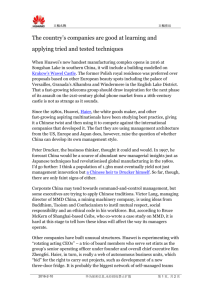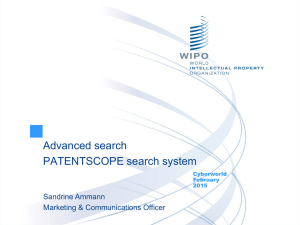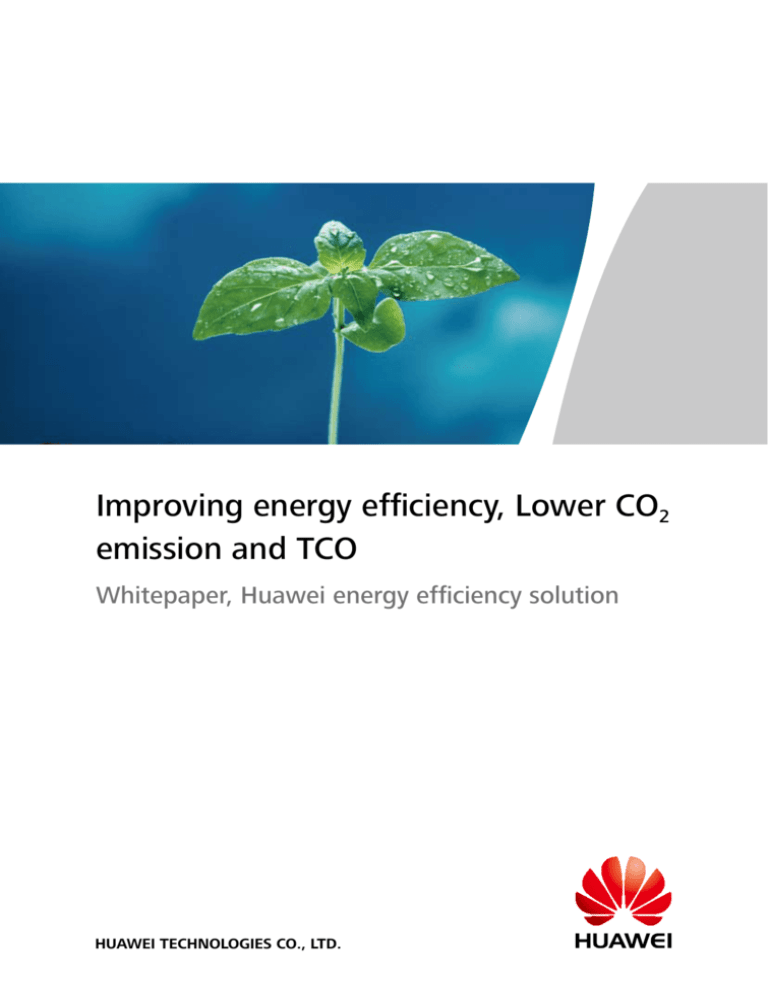
Improving energy efficiency, Lower CO2
emission and TCO
Whitepaper, Huawei energy efficiency solution
HUAWEI TECHNOLOGIES CO., LTD.
Content
Executive summary ..........................................................................1
Introduction ................................................................................... 2
Wireless sites .................................................................................. 3
Fixed access .................................................................................... 5
Central office .................................................................................. 6
Transmission network ..................................................................... 7
Packaging and transportation ......................................................... 9
Conclusions .................................................................................. 10
Glossary ....................................................................................... 10
Whitepaper, Huawei energy efficiency solution
Executive summary
A
ccording to the International Energy Agency (IEA) statistics
in 2008, global energy consumption increased 73% and
CO2 emissions increased 79% from 1973 to 2006. Energy
consumption and resulting enhanced greenhouse effect is thought
to have led to a series of natural disasters. Environmental concern,
declining natural resources and climate change has become an
important concern to the world. After accounting for several
energy crises during the past 30-40 years, we today find our selves
in a world where energy price does not truly reflect the damage
caused to the environment. As more and more manufacturing
utilizes increasing amounts of energy, the industry is increasingly
coming under pressure to reduce its energy demand in order to
find cost savings.
From a global perspective, compared with coal, iron and steel,
nonferrous metals industries, the telecommunications industry is
not the most prominent industry of energy consumption or CO2
emissions. However, according to data in annual reports and CSR of
leading telecom operators, telecommunication industry consumes
rather a large amount of energy, and some operators were listed in
the largest energy-consumption companies in their countries.
Pressure from the community, public, as well as government’s
commitment to improve energy efficiency in international
organizations, is a result of both dwindling reserves of primary
energy such as fossil fuels and increasing CO2 emissions, and
this has resulted in pressure being placed on industry to reduce
demand. The expected, rise in the cost of primary fuels, especially
with rising coal and oil costs, has had a negative impact on
industry. Punitive measures such as differential pricing launched in
some countries contribute to energy price as well. On the demand
side, the communication industry, is in a development phase in
most emerging and third world economies, and being pressurized
to reduce energy demand in first world economies. Subscriber
and service growth in emerging market and the explosion in
bandwidth growth within developed markets, will inevitably
lead to new network renewal and expansion programs. The ever
increasing number of peripheral equipment running online has
and will continue to lead to increased demands for energy supply.
Energy costs have risen as a result of this growth putting operators
under long-term financial pressure to reduce energy costs.
in research and have investigated several areas of energy efficiency
and emission reduction. We have found that in the life cycle of
telecommunications products, the operational phase consumes
most energy. In this stage, CO2 emission accounts for about 60%
of total emission during a whole life cycle. During the operational
phase, energy consumption and CO2 emissions generated by
the access network, including mobile and fixed access networks
account for the largest energy demand and emissions. In different
operating environments energy consumption as a proportion of
the access network varies, usually ranging from 50% to 70%.
The modern telecommunication network can generally be divided
into three parts, namely the access network, the core network and
the transmission network. The energy consumption of these three
parts is very different.
•• Access network is a key focus area for energy efficiency within
the network. It includes the access and auxiliary equipment, in
particular the cooling facility. The use of sustainable energy is
often applied in this part of the network.
•• The equipment within the core network is usually more
concentrated in central physical locations. With old network
architecture often in need of optimization. Legacy hardware
equipment is usually high in energy consumption, with
traditional servers having high energy demands.
•• Finally the transmission network, where network routing and
route optimization occurs, this is a key part of the network
where energy efficiency can be found. This area mainly consists
of routers and optical networking equipment.
In addition to the operations energy cost of the network, the
supply chain consisting of additional items such as packaging
materials and the need to reduce material consumption for
transportation and other demands is also an area of concern.
As a result of the market pressures and government planning
operators and equipment vendors have begun to look at
emission reduction and developed energy efficiency plans
based on sustainable development. In the past 10 years, the
telecommunications industry has made great progress within
this field. Technology innovation and recent product updates
has led to continued declining energy consumption per unit,
with some operators having saved more than 50% of their
previous energy demand.
Huawei along with some of our operator partners have cooperated
>1
Whitepaper, Huawei energy efficiency solution
Introduction
W
hen considering the holistic picture, the development
o f a c o m p re h e n s i v e t e l e c o m m u n i c a t i o n s
infrastructure has the potential of reducing
energy consumption and CO2 emissions across other sectors of
society. Telephone calls, video conferencing, and other means of
telecommunication can help to reduce the travel requirement of
the consumers, whether this be enterprise of for private use. SMS,
Internet and other electronic means of telecommunications can
also play a part in reducing the dependency on other media such
as postcards, greeting cards, letter and so forth. The sustainable
development of these kinds of services should continue to reduce
the carbon footprint of individuals and businesses. In short,
telecommunication services can support and contribute a lot to a
greener GDP and to the development of a harmonious society.
Huawei believes that improved energy efficiency and reduces
emissions brought about by the solutions delivered to market by
the telecommunications industry could support the development
of a Carbon Neutral industry. This will contribute to the
development of a greener national GDP, while also reducing the
cost of operations for telecommunication companies in the longterm. We believe that TCO (Total Cost of Ownership) is key and
should be considered in the network's energy reduction and
solution design.
Huawei has developed several life cycle analysis assessments (LCA)
for products, and have focused on access sector, with the base
station within the mobile network and the access hub within the
broadband network of initial concern. Our conclusion from the
LCA assessment is that for typical access products, the operation
phase is the largest contributor to carbon emissions, accounting
for about 60% of the whole life cycle. That means that operators
will face significant pressure to find energy-saving as they build out
their networks with expected demand.
From the energy consumption point of view, Huawei analyzed
a number of customers’ network energy consumption data
and found that main form of energy consumed by operators
is electricity power. And access network, including wireless site
and broad / narrow-band access site, is the main part of power
consumption. Energy consumption of wireless sites account for up
to 70%+ of the total energy consumption in a number of mobile
operators. Energy consumption ratio of access part in fixed carriers
is lower compared to the mobile, but also, in general, accounts for
more than 40%.
To sum up, the energy saving potential was found to be most
feasible as a product of usage demand within the access
part of the network thereby also offering the highest energy
efficiency potential, followed by the core network and then the
transmission network.
In the rest of this paper we outline some of the key points to
enhance energy efficiency within the access, core and transmission
networks. We also explore in the field of transport and packaging
to reduce energy consumption and carbon emission.
>2
Whitepaper, Huawei energy efficiency solution
Wireless sites
increasing the radius of base station coverage. In practice, the
two ways mentioned are usually used to reinforce each other.
The result being that with suitable network planning and strong
coverage-capable equipment one can save more than 25% of the
energy consumption, and realize a significant TCO saving in a wide
area coverage scenario.
Compared to the network planning method described above, the
energy saving at the network element level is often more feasible
in more scenarios and has less limitation. Usually, there are only a
few network elements within a mobile site. In most cases these
are only the base station, transmission and cooling equipment.
Among them, the power consumption of the base station is
normally much larger than the other devices. It’s the key point
where energy efficiency can be examined and implemented. In
addition, the energy consumption of the cooling system needs to
be considered. After analyzing several of our customer’s networks
we determined that at a typical site with air-conditioning, the
energy consumption by the air-condition can account for about
30% of the total energy consumed at that site; so the cooling
system is also a key focus for energy saving.
Sustainable energy is also another topic for consideration in the
energy-saving of a site, as in remote areas, it’s often feasible to
introduce a new energy system from the perspective of both
emission reduction and energy cost saving.
Our focus now will be on the possible energy saving within the
base station, the cooling systems and on new energy systems.
W
ithin mobile networks, the number of base station
sites is far greater than the equipment deployed in
the central office and it is rising fast as demand for
greater coverage and capacity increases. The energy demand
in mobile networks has accounted for over half of the mobile
network demand, peaking in some instances up to 80% of overall
consumption. This is a key area in mobile networks where energy
saving can be sought and addressed. When analyzing the energy
efficiency of base stations, this can be analyzed from two different
perspectives, first the network topology level and second the
network elements level.
One theory of energy-saving at the network topology level is to
enhance the unit of energy efficiency by reducing the number of
sites in the network. There are two ways to reduce the number of
sites, the first is by increasing the coverage efficiency and lowering
the system spending through efficient network planning, thereby
serving the most users with least number of sites. The second is
to enhance the capability of the base station equipment allowing
it to cover and serve a greater area. As with any technology,
there are trade-offs that will need to be considered. Several key
technologies, such as Transmitting Diversity, Adaptive MultiRate (AMR), High Receive Sensitivity and other, all contribute to
Energy efficiency of base station equipment:
The base station is made up of three parts, the baseband unit,
the radio component and the feeder. The radio part is the largest
energy-consuming entity of the base station consuming more than
80% of the base stations energy demands. In the radio, it is the
power amplifier that is the largest energy consumer, accounting
for about 50% of the radio’s power consumption. Therefore,
improvement in the efficiency of the power amplifier is one of the
key areas that needs to be considered in order to enhance energy
efficiency within the base station equipment.
Multi-carrier technology is one way to improve the efficiency of
the power amplifier. New multi-carrier base station products (such
as: GSM QTRU BTS technology) can help to improve efficiency
and reduce power consumption. In the case of using 6 carriers,
Quadruple transceiver unit (QTRU) technology can reduce the
maximum energy consumption of the PA by up to 30%. Other
ways to improve the efficiency of the power amplifier include
intelligent match; a smart regulator; and a new high-performance
amplifier and etc.
Reducing energy waste is another aspect that can enhance energy
efficiency at base station sites. Traffic levels and demand for service
>3
Whitepaper, Huawei energy efficiency solution
of the cooling systems energy consumption is therefore a key
consideration for energy-saving.
For indoor macro stations, smart direct ventilation systems are a good
way to pump fresh air in and hot air out to reduce the demand and
thus power consumption of air condition systems. If the outdoor
temperature is too high, and the direct ventilation can not meet the
requirements for cooling, the smart air-conditioning system will start in
order to protect the stability of the Base station equipment.
For outdoor macro-station plants, the demands of the cooling
systems power consumption may also be reduced by utilizing a
ventilated outdoor cabinet.
within the busy and leisure time of the mobile network is often
very uneven. How to reduce network power consumption during
leisure time is the second key consideration for energy saving.
This can be accomplished by optimizing the power distribution by
utilizing smart turn off technology.
In a typical dual-band GSM network, the most effective energy
saving technology is the "site-level" turn-off. The high frequency
site is switched off in low-traffic periods and re-powered to an on
status when the traffic levels pick up based on a predetermined
demand threshold. Turning off of the base station in periods of
low or zero demand results in significant power consumption
savings. The base station turn off technology also includes the
options for carrier turn off and time slot turn off. The difference
in options being dependant on the size of the particular site with
time slot turn-off being easier to realize and refine through lowflow management processes, than carrier turn off.
A third key point in base stations energy-saving options is to
reduce the energy waste of the feeder. Energy consumption of
the feeder itself is not large, but it has a significant impact on the
coverage ability of a particular base station site. Because it greatly
reduces the power consumed at the top of the tower, it results in
a substantial decline in the efficiency of the overall base station.
Feeders can lead to about on average a 50% loss of power at a
typical site. This problem can be solved by deploying distributed
base station architecture and through the design of smaller base
stations. In actual deployment scenarios of mobile networks,
we found that replacing a traditional macro base station with a
distributed base station we could achieve more than 40% power
consumption savings without impacting the output power. The
distributed nature of the architecture can bring savings in location,
room leasing and in the auxiliary cooling system. These all help to
reduce the site power consumption either directly or indirectly.
The Huawei high-performance base station products and the
distributed architecture all help to realize a decline in TCO, with these
two factors achieving about a 10% reduction in the network TCO.
Energy Efficiency of Auxiliary equipment at
the BTS site:
The cooling system is normally the largest energy consumption
item of the sites auxiliary equipment. To reduce the demands
>4
There are two typical problems in the use of direct ventilation, the
first is that the battery backup plant usually has a strict temperature
range requirement and doesn’t work well in some cases of the
direct ventilation. The second problem is the quality of the air. In
practice, we have found that the battery problem can be solved by
the introduction of a low-power battery air-conditioning cabinet
to manage the plants operating temperature. In regions where
the air quality is low, a "heat exchange system" can substitute
for the direct ventilation system to prevent the harmful effects of
dust. "Heat exchange systems" are roughly similar in principle to
direct ventilation, with the advantage that the air does not enter
the equipment enclosure thereby ensuring that the equipment
and the dust-protecting grid is not affected by dust pollution and
minimizing manual cleaning costs.
Renewable energy systems:
The most direct way to reduce CO2 emission is through the
introduction of renewable energy systems, such as solar energy,
wind energy and bio-energy plants. These emission-free energy or
low-emission energy are the most effective choices for companies
to reduce carbon emissions. Application of wind and solar energy
is limited by local climatic factors. They are usually used in remote
small sites where the wind and solar resources are enough to
support the system at those particular sites. Renewable Energy
may also be used as a supplementary energy source in a location
where the public power supplies are unstable.
For these small remote sites, use of public power is usually
expensive and difficult to obtain because of high cost of
power transmission and distribution. On the other hand, small
sites do not consume much energy, so operators can use oil
generator systems to solve the energy problem. However, most
generator systems have relatively low energy conversion rates,
high purchasing cost and short life expectancy, while requiring
high levels of maintenance. The cost of fuel consumption in a
generator is normally several times higher than the public power
system. Depending on the circumstance the introduction of new
energy can be economically viability. Based on current data from
our Africa region, the TCO of renewable energy system such as
wind and solar energy, they will equal generator system costs in
3-4 years. At this point, the renewable energy system can save
significant OPEX costs because it no longer consume any electricity
or diesel, with the added benefit of both the carbon emissions and
the TCO being reduced.
Whitepaper, Huawei energy efficiency solution
Fixed access
C
urrently, based on research from most countries, the
prediction is that the replacement of traditional POTS
access equipment is imminent. xDSL has developed
rapidly and many countries now support sizable broadband
data networks. The deployment of FTTx increasingly seems likely
with the predicted trend being that FTTH may substitute copper
cable over the next few years in many economies. Our research
shows that narrow-band, broadband (BB) access is normally the
highest energy consumer in fixed networks. These two parts, the
POTS and BB access network consumes up to 50% of the whole
network power consumption. Making the narrow-band and
broadband access nodes a key point of seeking to reducing energy
consumption within fixed line networks.
With the traditional POTS narrow-band access node, there is
not much room to improve the energy efficiency; however the
narrow-band access still consumes a large proportion (about
25%) of the overall energy consumption in the typical fixednetwork. Huawei believes that network migration to more
effective and efficient access solutions may be the best way to
solve this dilemma. According to our data of previous network
transitions, a NGN migration can reduce about 40% of network
energy consumption.
A large number of newly deployed xDSL access equipment
transitions is currently in progress across several regions. We
would recommend that fixed network operators focus on xDSL
is a key part of their energy efficiency plans. A recent EU Code of
Conduct standard (on energy efficiency) has given strict guidance
for DSLAM and MSAN products. The CoC guidance provides
for a L2 low-power mode for DSLAM equipment being utilized
during what is described as leisure time.
Equipment meeting this guidance will greatly
reduce the demand for power and ensure
less waste of power, leading to cost savings.
Conventional methods for DSLAM equipment
to reduce energy consumption also include
dynamic fan speed adjustment which can
reduce noise as well as energy consumption.
A fanless MxU design at the aggregation of
the access network is also an effective way
to reduce power on noise in the network,
saving about 20% of energy consumption and
creating a quieter environment.
For xDSL equipment, Dynamic Spectrum
Management (DSM) technology can reduce
unnecessary power consumption by eliminating crosstalk and
allowing networks to utilize less amplification, or line power. Power
consumed by the line side of the DSL line accounts for 40% of the
total port power. With most of the power consumed by DSL lines
being energy wasted due to the disproportionate amplification
required to overcome high margins of line noise. DSM technology
automatically adjusts the DSL line power spectrum densities (PSD)
template, thereby eliminating crosstalk and improving the line rate
by at least 15%.
Cooling is also very important issue to the distributed access
network equipment. Thousands of air-conditioning systems
spurting out CO2 emission and utilizing energy is putting pressure
on operators to find alternative ways to solve the issue. For new
BB access nodes, the ideal way to cool is to use a natural direct
ventilation system. For example, an outdoor directly ventilated
cabinet can provide all of the cooling and reduce the energy
consumption demand if the air quality and temperature are able
to meet local requirements. In other circumstances in order to
meet stricter local requirements we may need to adapt to an
alternative ventilated cabinet. Based on our tests, our equipment
can support a temperature range in the direct ventilated system
of up to 46 degrees.
Utilizing ground-source heating in a cabinet is also an alternative
way of using natural cooling. Based on tests in a customer's
network, the coefficient of performance (COP) (Energy Efficiency
Ratio - EER) of the ground-source heating cabinet was 108. It
showed ground-source heating as an effective way of providing
cooling. The effect is better than the direct ventilation method
which had a COP = 60 as a comparison.
Structure for the Geothermal Unit
>5
Whitepaper, Huawei energy efficiency solution
Central office
T
he central office is often a large scale room with many
different kinds of equipments in it; these could be access,
aggregation, transmission or any other form of product
used in the development of a network solution. Taking a holistic
view of the above network, much of their service architecture
is based on servers. Traditional server technology has reached a
high-level of maturity after being deployed for several years. But
it hasn’t evolved as much to offer many advantages in energy
efficiency as it consumes a lot of energy, takes up a large area and
has a very strict temperature requirement.
The most effective way to reduce energy consumption in central
office is often through network reconstruction. ALL-IP network
architectures can effectively reduce energy consumption and
TCO more than when compared to traditional TDM architectures.
Based on statistics, and compared to TDM architectures, the ALLIP architecture can reduce about 20% of the TCO, of which 20
percent comes from the energy (electricity) consumption reduction.
At the equipment level, Huawei believes that the first key energysaving measure in the central office should be on replacing
the traditional servers with blade servers so as to achieve a
significant reduction of hardware energy consumption. In practical
applications with our customer, a service platform based on ATCA
blade servers instead of traditional servers reduced 40% of the
total power consumption and reduced the footprint by 50%while
raise the performance by 40%.
In the core network equipment, the software can also be improved
to achieve a reduction in power consumption. As an example MSC
CCU software by activating the switch off technology can achieve
an 18% energy saving.
In addition, network equipment like the MSC and HLR can
make use of the new features within the framework to achieve
a reduction in power consumption. In dense urban scenario’s,
the MSC can share the equipments capacity by means of MSC
Pooling. Traffic in the dense urban areas is often concentrated
in commercial zone during office hours and concentrated in
the residential area in non-office
hours. The traditional way of MSC
deployment will waste capacity. Using
the MSC Pool mode, the system
capacity can be shared between
different areas allowing a 20% energy
savings to be realized across the
solution. For the HLR, the new ngHLR
is based on a distributed architecture,
>6
with actual deployment scenario’s showing that distributed HLR’s
can save up to 50% energy as well as meet the additional needs
of disaster recovery and increased reliability.
Besides savings in equipment power consumption, the heat
management as a solution in the central office is another very
important part of energy saving. Today the cooling power
consumption of a central office or data center can be as high as
45% to 50% of the total power consumption.
The key in heat management is design, including the ventilation
mode, the distribution of a cold / hot-channel and optimization
of the power equipment layout. For example air flow from the
bottom to the top has a 20% higher cooling efficiency than air
flowing from top to bottom. In the design of the air flow path,
the way the heat path vs cool path is designed could raise cooling
efficiency. A simple example is to how the cabinets are arranged
face-to-face and back-to-back and ensuring the heat flows from
one side and the cooling from the other.
The past typical power consumption for a cabinet in most central
offices was between 1-2KW. However, with the development of
chip and integration technology as well as the rapid deployment of
large scale power equipment, power consumption of certain rack
may rise up to 8-10KW. This brings challenges to traditional room
cooling. Therefore, if there are a small number of large-power
cabinets in a central office they should be scattered throughout
the room, so that cooling redundancy can be used to reduce the
probability of equipment downtime.
As verified in an actual network, the Power Usage Effectiveness
(PUE) of the central office can be improved significantly with the
above measures. Reconstruction of the old room with, smalldesign-changes could reduce the PUE from 1.95 to 1.8. That
means that cooling system could save about 16% of there energy
demand. If the large-design-change are incorporated such as
precision air flow systems are designed in, the cooling system can
even save more than 30% of its energy demand.
TDM Equipment Central Office
NGN Equipment Central Office
Whitepaper, Huawei energy efficiency solution
Transmission network
Transmission networks are the most important foundation part
of current communication networks. The transmission network
consists mainly of core backbone routers and optical networking
equipment. Equipment in this domain are usually bulky with power
consumption up to 1 kilowatt. Looking at the energy efficiency of
transmission networks we can discuses this at three levels, that of
network, equipment and devices.
At the network level, resources utilization of the traditional circular
network SDH is low, as often half of the bandwidth is set aside
to use as protection. For example, in a STM-64 loop, after the
deduction of half for the protection slot, there are only 32 VC4
channels that can be used to carry business between any two
adjacent nodes in the ring network. If the 32 slot are loaded
and there is new demand for business, the only way to support
this is to build a new circuit, which raises the network costs and
energy consumption. In addition, the traditional network routing
algorithm needs a large number of ports and bandwidth resources
for new business, making it difficult to raise the efficiency
(bandwidth utilization) of the optical line.
Compared to ring networks, a mesh network has a high
resource utilization rate. New bandwidth for the purpose
of protecting is only 1 / (N-1) (N is the number of optical
connections for the nodes) at the ideal state. For example, a
node with a 6-ray direction only need 20% of the bandwidth
reserved for the purpose of protection. While the traditional
ring network will need 50% of new bandwidth resources for
the purpose of protection. Bandwidth saved could be used
directly to load new services, ensuring that the investment from
operators is protected effectively.
The introduction of the Open Transport Network (OTN) makes
it possible for an automatically-switched optical network
(ASON) to be applied at the optical level. The limitation of the
ring network is broken by the MESH network. Optimization of
intelligent algorithms for network routing can raise the rate of
direct connection, service protection and flexibility of restoration.
The work notes passed through to operations and the required
bandwidth and port resources could be reduced, resulting in
savings. The efficiency of the optical line (bandwidth utilization
rate) is raised resulting in the efficiency of the network load being
increased. After the introduction of ASON, by changing the
network topology and with reasonable allocation of service load,
bandwidth utilization can be raised from about 33.6% of the MSP
/ PP protection method to 75% of protection and resumption
method. As a result, energy efficiency is significantly increased.
As the bearer layer of core routing, flexible OTN and λ exchange
come together with GMPLS scheduling, it will be possible that
services of the core router may bypass the optical transmission
level, raising the possibility of direct connection services. As a
result, the overall cost and power consumption of "Router + send"
get optimized. The overall power consumption can be reduced by
more than 20%.
On the equipment level, the complexity of network equipment,
low integration and poor compatibility are common problems
faced by the transmission network. They not only cause
unnecessary power consumption and space consumption but also
increase the costs of network management and maintenance.
?
Traditional Network vs. ASON Network
>7
Whitepaper, Huawei energy efficiency solution
Ro u t er cl u s te r sy s t e m is g e ne ra lly u s e d in t h e core
telecommunication network, as a large system with large power
consumption. Traditional high-capacity core router systems are
commonly formed by multiple frame clusters, generally only 1 +2
cluster model are supported. That is to say, a central exchange rack
is required in order to make the interconnection of two general
core routers, this increases the power requirement. Cluster core
routing is the solution for this problem. By using this technology
a single frame cluster can smoothly evolve into a back-to-back
two frame cluster and into Multi-frame clusters. Data shows that
compared to the 1 +2 cluster model, back-to-back cluster models
with the same dealing capacity can reduce power consumption by
about 30%. At the same time, material consumption and the area
required decreases by one third.
On the device level, the transmission network equipment providers
must ensure that the devices in the transmission network meet a
variety of international environmental standards. They must reduce
the device's toxic waste which is hard to recover and, if possible,
implement a variety of energy-saving and emission reduction
design criteria.
By contrast, at the equipment level, more equipment slots and
flexible configuration of single boards means flexible configuration
of the network node and improved redundancy. The compatibility
of the product family design also means that fewer single
board species and fewer varieties of spare parts. providing the
most appropriate equipment for each network node, network
optimization, reducing equipment, reducing the over design of
the network, which not only works towards reduced energy
consumption, but also simplifes network management and
maintenance, thereby reducing maintenance costs.
At the device level, there are some designs that can achieve
the purpose of energy-saving and emission reduction. These
designs include:
•• PID technology that can significantly enhance the integration
of the WDM OUT unit, reducing power consumption by more
than 40% compared to common OTU units;
•• Advanced cooling technology that could enable long-
term running of equipments in a 30°C - 35°C temperature
environment, thus greatly reducing the power demands of
room air-conditioning;
•• Smart fan technology that can adjust the speed of fans
precisely based on equipment temperature monitoring, to
reduce the power consumption of fans, which accounts for as
high as 10% of the total power consumption;
•• Simplifying the voltage types and using high-performance
DC / DC power modules can increase the power conversion
efficiency to a maximum of 85-90%;
•• Built-in temperaturel control chip which can implement
intelligent monitoring combined with intelligent power
consumption software for configuration management of the
equipment, together with technologies like CPU adjustment,
automatic switch-off of ports during low demand periods,
making power consumption manageable and configurable.
power consumption per 10G port(W)
250
200
200
150
102
100
76
60
50
0
10G LPU
20G LPU
40G LPU
100G LPU
2007
2008
2009
2010
Improving Energy Efficient through ASIC
>8
Whitepaper, Huawei energy efficiency solution
Packaging and transportation
I
n the transportations of communications equipment,
packaging consumes a large amount of natural resources –
for example timber, with continued industry use seen as a
long-term threat for forests. In order to reduce the consumption
of timber, the industry's leading suppliers are working hard
to promote renewable packaging materials and improve the
recycling of these resources. At the same time, we have reduce
the consumption of packaging materials by utilizing lightweight
materials and smaller packaging, continually investigating more
appropriate packaging, and extending the life cycle of the
packaging products through the establishment and improvement
of an effective Recovery System. These can be summarized by
using the 6 R concept, that of: rational design, reducing supplies,
recycle, reuse, recovery, and renewable.
The "Transportation cabinet" is typically a reusable unit with
associated reusable packaging. This solution is based on recycled
wood materials, visualized packaging technology, assembly
technology, standardization and appropriate design. Together with
a universal logistics platform, the "Transportation cabinet" solution
reduces the consumption of natural resources such as wood
from forests in the packaging and logistics stage, and promotes
sustainable development of resource-saving and environmentally
friendly packaging and logistics within the industry.
By working in partnership with our customers on their network
implementation projects we have shown that, compared to the
legacy packaging solution, the "Transportation cabinet" solution
can save about 50% of timber, reduce about 20% to 30% of the
packaging weight, and extend up to 2 to 4 times the service life
of the Packaging, while reducing about 5% to 10% the life-cycle
cost, and raising operational efficiency about 80% to 90%.
According to Huawei shipment statistics, using this solution
and our ongoing continuous improvement program, 12,000
cubic meters of timber consumption, 2,700,000 liters of oil
consumption, 750,000 KWH power, and 6,172,000 tons carbon
dioxide emissions will be saved every year. This is equivalent to
an annual reduction of 14,700 square meters Deforestation,
saving fuel consumption of 6,750,000 ordinary family cars in
China, or saving electricity consumption of 2,080,000 ordinary
Chinese families.
Reuse of Visible Cabinet Package Saves 50% Wood Consumption
Traditional paper package
Stock
Transportation
visible transportation cabinet green package
Arrival
Return
>9
Whitepaper, Huawei energy efficiency solution
Conclusions
Communication network will continue to expand in the future
due to increasing demand for mobile subscribers in developing
market, FTTx broadband build-out in developed markets and
continuing demand for high bandwidth services. This means that
increasing number of equipment will be deployed in networks,
putting emission and finance under pressure. Operators, equipment
manufacturers and other related industry participants will continue
to search for solutions to reducing costs and emissions.
Huawei is committed to continuous efforts:
111 Continuously improving the energy efficiency of our products to
help our customers and partners reduce carbon emissions and
improve their TCO.
222 The development of a highly efficient closed-loop control
system in the supply chain management, and limiting our
environment impact in the manufacturing and transport
process.
333 Cooperating with operators, to develop and launch more userfriendly ICT services that reduce unnecessary travel and logistics
for our global society, while at the same time actively promoting
the use of clean energy and reduced carbon emissions for the
whole of society.
Glossary
AMR – Adaptive Multi-Rate
IEA – International Energy Agency
ATAE – Advanced Telecom Application Environment
ICT – Information and Communication Technologies
BSS – Base Station Subsystem
LCA – Lifecycle Assessment
BSS – Business Support System
NGN – Next Generation Network
CoC – Code of Conduct
OTU – Optical Transmit Unit
COP – Coefficient of Performance
PBT – Power Boost Technology
CSR – Corporate Social Responsibility
POTS – Plain old telephone service
DSM – Dynamic Spectrum Management
PSD – Power Spectrum Densities
DSLAM – Digital Subscriber Line Access Multiplexer
PUE – Power Usage Effectiveness
EER - Energy Efficiency Ratio
QTRU – Quadruple. Transceiver Unit
FTTx – Fiber to the x
RRU – Remote Radio Unit
GDP – Gross Domestic Product
TCO – Total Cost of Ownership
> 10
Copyright © 2009 Huawei Technologies Co., Ltd.
All Rights Reserved.
The information contained in this document is for
reference purpose only, and is subject to change
or withdrawal according to specific customer
requirements and conditions.
HUAWEI TECHNOLOGIES CO., LTD.
Add: Huawei Industrial Base
Bantian Longgang
Shenzhen 518129, P.R. China
Tel: +86-755-28780808
Version No.: M3-000430-20090203-C-2.0
www.huawei.com


